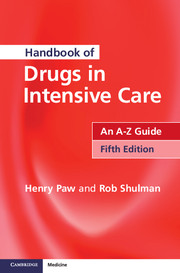Book contents
N
Published online by Cambridge University Press: 05 November 2014
Summary
NALOXONE
This is a specific opioid antagonist. The elimination half-life is 60–90 min, with a duration of action between 30 and 45 min.
Uses
Reversal of opioid adverse effects – respiratory depression, sedation, pruritus and urinary retention
As a diagnostic test of opioid overdose in an unconscious patient
Contraindications
Patients physically dependent on opioids
Administration
• Reversal of opioid overdose: 200 μg IV bolus, repeat every 2–3 min until desired response, up to a total of 2 mg
• Infusion may be required in patients with renal impairment or those who had taken long-acting opioids, e.g. MST, usual starting dose is 60% of initial IV bolus dose infused over 1 hour, then adjusted according to respiratory rate and level of consciousness, e.g. if the initial bolus is 1 mg, the infusion is started at 0.6 mg/hour. Dilute 10 mg to 50 ml with sodium chloride 0.9% or glucose 5%
• Reversal of spinal opioid-induced pruritus: dilute 200 μg in 10 ml WFI. Give 20 μg boluses every 5 min until symptoms resolve
Titrate dose carefully in postoperative patients to avoid sudden return of severe pain
How not to use naloxone
Large doses should not be given quickly
Adverse effects
Arrhythmias
Hypertension
Cautions
Withdrawal reactions in patients on long-term opioid for medical reasons or in addicts
Postoperative patients – return of pain and severe haemodynamic disturbances (hypertension, VT/VF, pulmonary oedema)
Organ failure
Hepatic: delayed elimination
NEOSTIGMINE
Neostigmine is a cholinesterase inhibitor leading to prolongation of ACh action.
- Type
- Chapter
- Information
- Handbook of Drugs in Intensive CareAn A-Z Guide, pp. 164 - 169Publisher: Cambridge University PressPrint publication year: 2014



